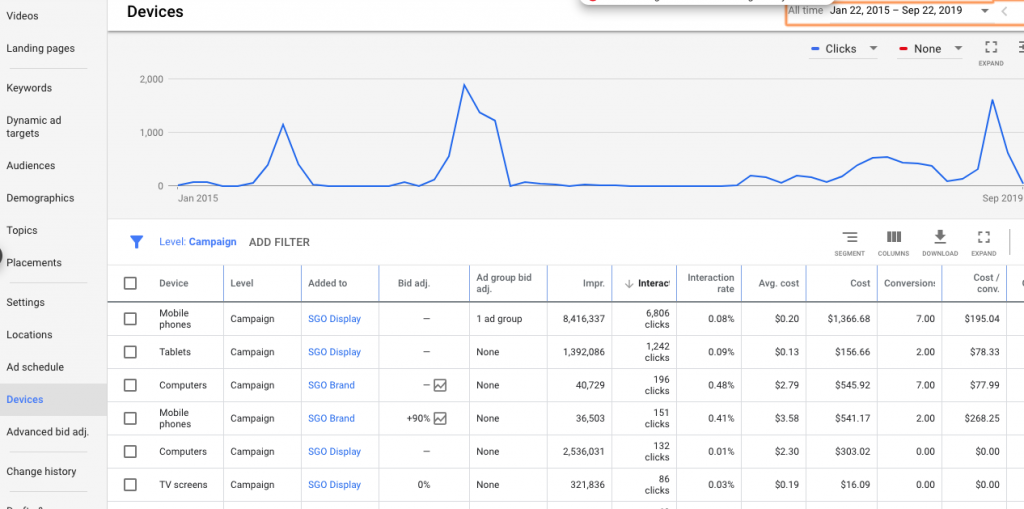Updated January 7, 2023
Reading Time: 6 minutes
Picking Your Targets
User behavior is different depending on the device we’re using. Our habits and intentions often change when we’re looking at a website on our desktop compared to when we’re looking at the same website on mobile. When user habits change, then so should our marketing tactics. That’s why device targeting, especially for PPC campaigns on Google Ads, is essential to your strategy.
The Google Ad system requires advertisers to create separate ads for desktop and mobile ads, for a good reason. Google has consistently indicated the importance of having a mobile-friendly website because the rise of smartphone usage has made mobile internet browsing the rule rather than the exception.
According to Statista, Google accounted for 93.25% of mobile search markets. If you’re not already, you need to be creating marketing for different types of devices.
What is Device Targeting?
Device targeting is a Google Ads tool that enables you to choose which ads are shown on which devices. In it, you can create mobile-only campaigns, specific ad variations for tablets, and different bidding strategies for desktop ad groups.
For Google Ads you have three choices:
- Desktop
- Mobile
- Tablet
You can also break things down further by specifically targeting different operating systems, so if for example, you’re selling software that only works on iPhones, you could exclude ads on Google Chrome (although that may be a risky tactic as iPhone users could still be using Chrome).
You can send users from mobile devices to a mobile-specific landing page or create totally different ads for users who are using iOS. Being able to create specific ads for specific platforms has another knock-on effect. It also allows you to increase, or decrease, bids separately for different devices. If you notice that mobile users are more likely to convert than desktop, then you can add bid adjustments for those campaigns or ad groups.
Mobile users could be doing anything, from riding the subway, to working out at the gym. Because of this attention spans will differ. Click To Tweet
Let’s use another example: you’re selling handbags online. 60% of your customers use mobile to find your handbag products. Additionally, you’ve noticed that the number of mobile buyers is growing faster than those on other devices. With the hope of increasing your customer base faster, you decide to set up a 25% bid increase for mobile phones. This means that Google will push most of your daily budget towards mobile users instead of spending it on desktop clicks that have a lower likelihood of converting.
Mobile Behavior
If you’re setting up different ads for different devices, the first thing to think about is why? What mobile user behaviors or trends have you noticed that will influence changes to ad text, ad graphics, ad placement, or landing pages?
There are several primary considerations when targeting mobile users:
- Screen size – A mobile or tablet screen is obviously smaller than a laptop or desktop monitor. Therefore, the search engine results page (and your landing pages/ website) will display differently. If your ads are shown in positions one or two on mobile, they will be at the top of the SERP, thus taking up almost the whole mobile screen. The SERP is more extensive on desktop, so your ads will take up a smaller percentage of the screen, potentially making the ads less visible or effective.
- On the move – Another thing to consider is what the user is doing while on mobile. When someone uses a desktop computer to browse Google, they’re typically sitting down on their work desk or home office. Mobile users could be doing anything, from riding public transit, working out at the gym, or waiting during an appointment. Different situations will put them in different frames of mind. Keep your mobile ads and landing pages simple and easy to skim for mobile users.
- High-value products – Considered purchases (a complex buying decision with a high degree of financial and/or emotional risk and reward) may be less likely to happen on a mobile device. With 34% of online purchases occurring via mobile devices, you rethink your conversion objectives when running mobile-only campaigns. Instead of focusing them on purchases, use CTAs that offer more content, or suggest that they join your mailing list.
Desktop Browsing
The same device targeting ideas apply to desktop-only campaigns. Desktop users interact differently than their mobile counterparts. If you’re not sure how to find this information, we have some suggestions.
1. A/B Test – The most straightforward way to determine how/ if your users behave differently is by creating two identical campaigns, running one campaign on mobile and the other on desktop. Then, review the results. Once you have supporting data, tweak each campaign to achieve your desired results. Get into your Analytics – Information on your website usage is broken down by device in Google Analytics. You just need to go to Audience > Mobile to see some information on how your users behave when browsing on different devices.
2. Analyze Analytics – Google’s free analytics tool, Google Analytics, collects critical website performance data. Website usage is available by the device. Go to Audience > Mobile for how your users behave when browsing various devices.
3. Heatmaps & Recordings – Tools like Hotjar, Lucky Orange, and CrazyEgg record users’ sessions (without personally identifiable information). Heatmaps and recordings provide data related to user behaviors based on device type. Hot spots, scroll depth, and mouse movements are ways to see where visitors click and what information they browse on a page.
Target Acquired
Hopefully, by now, we’ve piqued your interest in setting up device targeting for some of your Google Ads campaigns. Here’s our step-by-step video on getting it up and running.
How to Set up Device Targeting
Ready to set up mobile device targeting on Analytics? Google gives us the complete guide to setting up device targeting.
You can also use device targeting with Display campaigns. As a refresher, display campaigns are graphical ads that appear on websites that allow advertising. In addition to device types and operating systems, display campaigns will enable you to target specific device models, carriers, wireless networks, and ad inventory (space where publishers allow ads to run). These advanced mobile and tablet options aren’t available for other campaign types.
To target device models, carriers, networks, and ad inventory, you’ll need to do the setup somewhere else. If you want to do that, then:
- Click the Campaigns tab.
- Select one of your “Display Network only – All features” campaigns.
- Click the Settings tab.
- Under Additional settings, expand the “Device” tab, and select “Set specific targeting for devices”.
- To avoid showing ads on a specific device or ad inventory type, uncheck the box next to it.
- Click ” All options ” to target specific device operating systems, models, carriers, or networks, click “All options.” Select where you’d like your ads to show in the pop-up window.
- To set bid adjustments, go to the Devices tab from the page menu on the left, and do the same as we’ve mentioned earlier.
There’s more than one way to set something up in Google Ads. Please comment below if you find anything new about Device Targeting or a quicker way to get bid adjustments for devices set up!
How about Cross-Device Targeting?
Besides device targeting, marketers can expand to target more than one device. According to Pew Research Center, over 97% of Americans own a cellphone. Comparatively, three-quarters of US adults own a desktop or laptop, and over half own a tablet. Multi-device use, sometimes at the same time, is becoming more common. In a 2020 Statista survey, an average American has access to 10 connected devices at home. So, it’s evident that ads must work across devices. Cross-device targeting aims to deliver ads to their audience across devices by syncing information between your mobile, desktop, and tablet. It’s often used with omnichannel marketing, where businesses use unified and cohesive messaging across channels and devices.
There are two methods to achieve cross-device targeting:
- Deterministic Cross-Device Targeting – Deterministic cross-device tracking is a more accurate method of identifying your users. It can be based on an email or log-in credential you accessed on both mobile and desktop. The drawback is that users have to log in multiple times to connect those ad devices to each other. Companies like Google and Facebook utilize this.
- Probabilistic Cross-Device Targeting – From the word itself, probabilistic cross-device targeting is based on a model created from devices in the same location. It’s refined and validated using shared ad devices that are already known. It is limited to IP addresses & environments, so expect less accurate data.
The advantage of using cross-device targeting is the curated experience it gives to your audience. In addition, you also get a holistic view of the attribution & conversion acquisition flow.
Hitting your Targets
We think that setting up device targeting is an important step in setting up an efficient Google Ads campaign. If you’re not paying attention to your customers’ behavior then you can’t understand their motivations.
Photo credit – Top: Pexels
Photo credit – Bottom: Pexels



 Say Goodbye to Average Position – Google Ads Metrics Makeover
Say Goodbye to Average Position – Google Ads Metrics Makeover